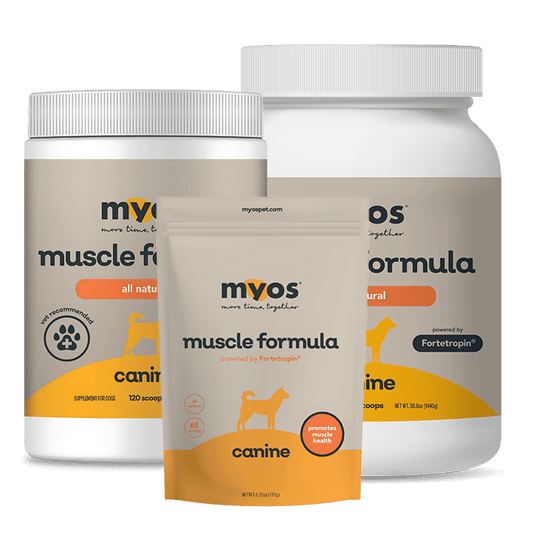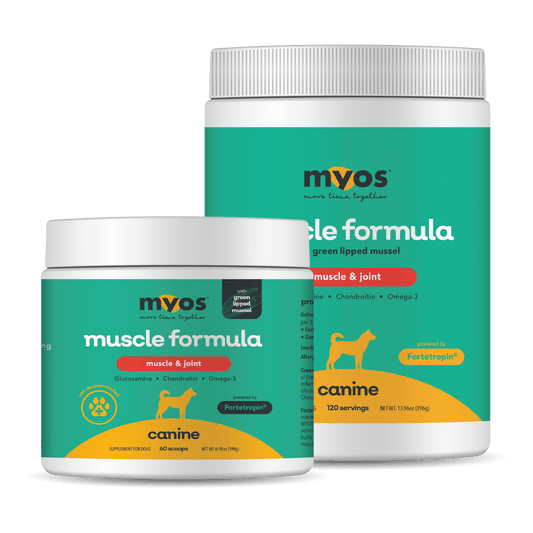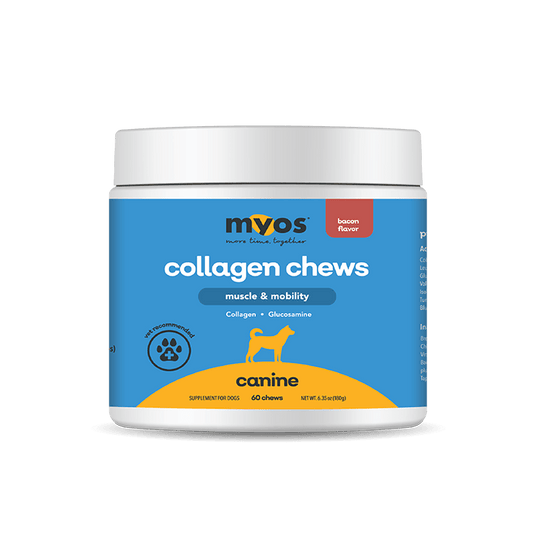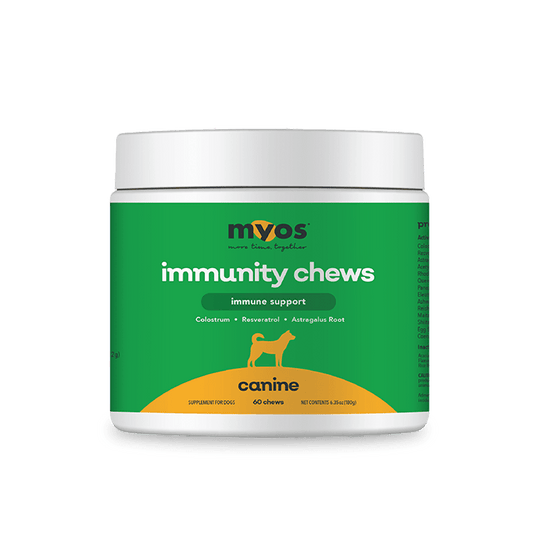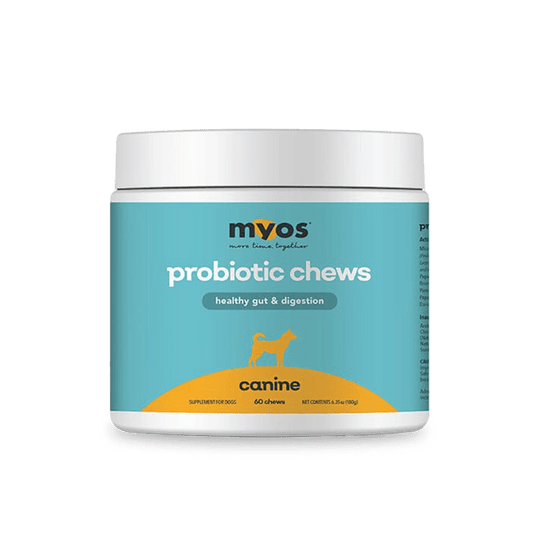Introduction
Tears or ruptures of the cranial cruciate ligament (CCL) are a common injury in dogs with symptoms that commonly include lameness, stiffness after exercise, swelling around the knee, difficulty lying down or rising along with pain or tenderness around the site of injury. Although surgery is an excellent treatment option to repair partial and complete CCL tears in dogs, it is not always a feasible option due to financial constraints or concurrent medical issues that the dog may be dealing with that would make surgery a risky option. One feasible option in such a scenario is canine orthotics. The downside to canine orthotics is that an imperfect fitting of the orthotic can lead to muscle atrophy. In this blog post, we will discuss the potential role of the nutrition product, Fortetropin to address CCL-injury related muscle atrophy.
What is Fortetropin?
Fortetropin is a nutrition product that is produced from 100% fertilized chicken egg yolk. Egg yolk powder products typically employ heating during the steps of pasteurization and drying. When egg yolk is heated, many irreversible biochemical changes typically occur. For example, proteins become denatured. Lipids become oxidized in addition to methionine residues on proteins. Fortetropin is manufactured from fertilized, chicken egg yolk using a patented [1, 2] low temperature manufacturing process that preserves the biological activity of the proteins, peptides and lipids found within egg yolk. An alternative to consuming Fortetropin or heat-pasteurized egg yolk is to consume raw egg yolk. Feeding raw egg yolk to small animals is very dangerous due to the high possibility of contamination from pathogens such as Salmonella and Listeria monocytogenes.

Impact of Orthotics on Muscle Atrophy
Researchers at Wilfrid Laurier University, Canada studied the impact of orthotics on muscle atrophy in a human clinical trial [4]. Eighteen young adults with pes planus were randomly assigned to either a control group (n=9) or an orthotics group (n=9). After 6 and 12 weeks, ultrasound measurements were made of the thickness of the flexor digitorum brevis, abductor digiti minimi, and abductor hallucis muscles. The researchers reported that after 12-weeks, subjects in the orthotics group experienced the following decreases in muscle cross-sectional area: 9.6% in the flexor digitorum brevis (p<0.001), 17.1% in the abductor digiti minimi (p<0.001), and 17.4% in the abductor hallucis (p<0.001). In order to prevent muscle atrophy, the authors recommended that patients be prescribed a strength training program when patients are undergoing treatment with orthotics for the feet.
In a separate study related to orthotics and osteoporotic vertebral fractures, long-term use of orthotics was found to be associated with muscle atrophy [5]. The use of orthotic knee braces to induce muscle atrophy has been commonly used by musculoskeletal researchers to gain insight into therapeutic and nutritional interventions that can attenuate muscle atrophy. Researchers at McMaster University, Canada used the unilateral leg immobilization model based on the concept of using an orthotic knee brace to induce muscle atrophy to study the impact of a novel amino acid composition, AXA2678 to reduce muscle atrophy [6]. In a separate study related to the unilateral leg immobilization model based on an orthotic knee brace, researchers at McMaster University found that omega-3 fatty acid supplementation is an effective approach to reducing muscle atrophy in young women that wore an orthotic knee brace for 2 weeks [7]
Fortetropin: Impact on Muscle Protein Synthesis and Recovery
Performed to repair tears of the CCL, tibial plateau leveling osteotomy (TPLO) is one of the most common veterinary surgical procedures in the United States. After TPLO surgery, the operated limb typically requires immobilization for about 8 weeks, resulting in significant disuse muscle atrophy. Veterinary surgeons and researchers at Kansas State University studied the impact of Fortetropin on muscle disuse atrophy in 100 dogs recovering from TPLO surgery [8]. A group of 50 dogs were supplemented with Fortetropin after undergoing TPLO surgery while another group of 50 dogs received supplementation with a mactronutrient-matched placebo, cheese powder, following their procedure. The research group at Kansas State University observed that the dogs that received Fortetropin supplementation following TPLO surgery did not experience statistically significant decreases in quadriceps muscle thickness in the affected (p=0.31) and unaffected limb (p=0.37). On the other hand, dogs that received a macronutrient matched placebo did experience losses in muscle thickness after TPLO surgery in the affected (p=0.03) and unaffected limb (p=0.02). Because the treatment of a CCL injury using orthotics sometimes results in immobilization of the limb, it is likely that Fortetropin supplementation will likely minimize muscle atrophy in this scenario as the underlying cause of muscle atrophy following TPLO surgery is the immobilization of the operated limb.

The impact of Fortetropin on the rate of muscle protein synthesis (MPS) on older adults by researchers at the University of California, Berkeley in a randomized, double blind, placebo-controlled human clinical trial involving 20 subjects (60-75 year old men and women) [9]. 10 subjects were given Fortetropin to consume on a daily basis for 3 week. The remaining 10 subjects were given a macronutrient-matched cheese powder placebo to consume during this 3 week duration. During this time, all subjects consumed heavy water (deuterium oxide) to serve as a tracer. To measure the impact of the nutritional supplement on the rate of muscle protein synthesis, all subjects underwent a muscle micro biopsy and high resolution mass spectrometry was used to measure the deuterium content in muscle proteins isolated from the muscle tissue samples. Subjects that were supplemented with Fortetropin experienced an ~18% increase in the rate of muscle protein synthesis relative to subjects in the placebo group.
Summary
Although surgery remains the most promising option to repair tears of the CCL in dogs, it is not always a viable option due to concurrent medical problems and/or financial concerns. In such a scenario, orthotics can be a promising option to manage the CCL injury of the dog. As discussed, a downside of orthotics is that they can frequently lead to muscle atrophy. Based on veterinary and human clinical studies that have been conducted with Fortetropin, it is likely that Fortetropin supplementation can minimize muscle atrophy in dogs undergoing orthotic treatment.
References
- Buxmann, W., Heinz, V., Toepfl, S. Process for producing a composition for increasing muscle mass. U.S. Patent # 11,051,524 B2. Issue date: July 6, 2021.
- Buxmann, W., Heinz, V., Toepfl, S. Process for producing a composition for increasing muscle mass. U.S. Patent # 10,165,785. Issue date: January 1, 2019.
- Buxmann, W., Heinz, V., Toepfl, S. Process for producing a composition containing active follistatin. U.S. Patent # 8,815,320. Issue date: August 26, 2014.
- Protopapas, Katrina, and Stephen D. Perry. "The effect of a 12-week custom foot orthotic intervention on muscle size and muscle activity of the intrinsic foot muscle of young adults during gait termination." Clinical Biomechanics78 (2020): 105063.
- Marchenkova, L. A., and E. V. Makarova. "Exercise therapy and bracing in patients with osteoporotic compression vertebral fractures." Voprosy kurortologii, fizioterapii, i lechebnoi fizicheskoi kultury96.4 (2019): 69-75.
- Holloway, Tanya M., et al. "A novel amino acid composition ameliorates short-term muscle disuse atrophy in healthy young men." Frontiers in nutrition6 (2019): 105.
- McGlory, Chris, et al. "Omega‐3 fatty acid supplementation attenuates skeletal muscle disuse atrophy during two weeks of unilateral leg immobilization in healthy young women." The FASEB Journal33.3 (2019): 4586-4597.
- White, Dana A., et al. "Fortetropin inhibits disuse muscle atrophy in dogs after tibial plateau leveling osteotomy." Plos one15.4 (2020): e0231306.
- Evans, William, et al. "Effects of Fortetropin on the Rate of Muscle Protein Synthesis in Older Men and Women: A Randomized, Double-Blinded, Placebo-Controlled Study." The Journals of Gerontology: Series A76.1 (2021): 108-114.

